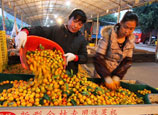
Ancient engineers also successfully tackled the complex geography and changing elevations in the Shandong region, stabilizing the key route carrying grain to Beijing in the north.
Theme park
Starting in 1958, the Tai'erzhuang stretch itself was bypassed by an expanded, wider canal system. The big system is still in use, mostly carrying coal, gravel and sand to the south. The older system used to carry grain from Jiangsu Province north to Beijing.
The 2km Tai'erzhuang channel is strictly for sightseeing today and is at the heart of a new "ancient town" that recreates in many ways the bustling canal town and transport hub that reached its peak in the Ming (1368-1644) and Qing (1644-1911) dynasties. The water comes from surrounding rivers, including branches of the Yellow River.
In 1938, the town was devastated in the famous Battle of Tai'erzhuang during the War of Resistance Against Japanese Aggression (1937-1945). It was an early victory for China.
The town has been completely rebuilt. The ancient town project and canal restoration began in 2006 and are still underway.
"It's so different now, even bigger and better than the old town before the war," says 79-year-old Li Jingshan whose family once ran a famous sweets shop along the canal.
This ancient-town theme park contains around 2 kilometers of renovated ancient canal and covers around 200 hectares. Admission is 160 yuan (US$25.70); more areas will be opened in the future.
The ancient canal flows quietly, only 50 steps from the visitors' center. An ancient-style bridge arcs over the canal and the pavilion atop the bridge is decorated with traditional painting and calligraphy. Willow trees line the banks of the winding canal. This section looks like a southern Chinese water town, such as Suzhou in Jiangsu Province.
Behind old Zhao stands the large new visitors' center, built in traditional Chinese style, with dark tiled roofs, upturned eaves and roof carvings of lucky animals. Wooden window frames are also carved and the building is decorated with colored carvings.
Zhao and many other locals helped clean up and landscape the stone canal. He then became interested in suo yi. Now he gets paid to dress like an impoverished peasant, demonstrate how the garments are made, and pose for photos. He poses for free, but if visitors want to take a photo with him or wear suo yi themselves, the price is 5 yuan.
Old Zhao's tourist spot is called "Old Man in Suo Yi," where he adds some nostalgia to the tourist experience.
















 Cumquat market in S China's Guangxi
Cumquat market in S China's Guangxi


![]()
